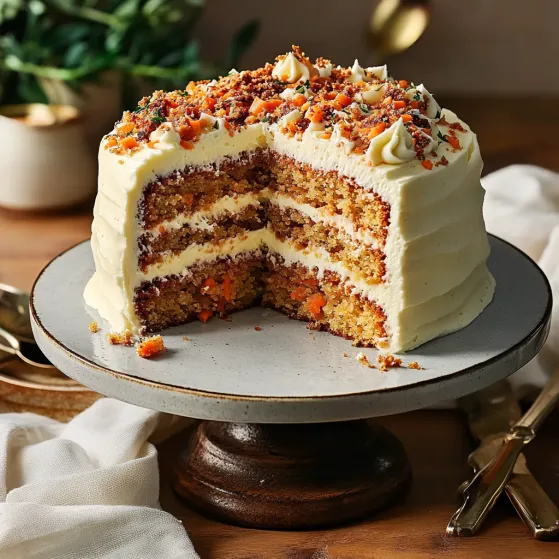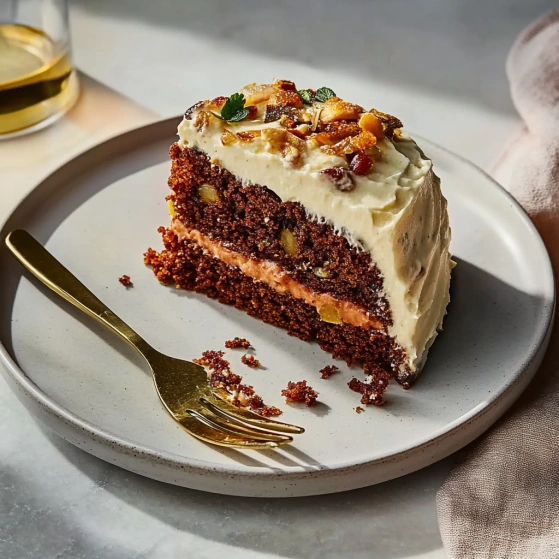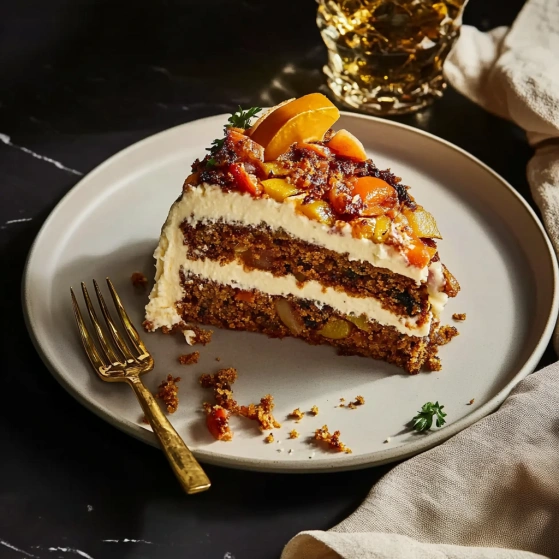 Pin it
Pin it
Carrot cake that strikes the perfect balance between moist, spiced sweetness and wholesome ingredients isn't just a dessert—it's a tradition that spans generations. This recipe takes the classic carrot cake to new heights with a careful blend of fresh carrots, warm spices, and surprising additions that create texture and depth in every bite. The natural sweetness of carrots pairs beautifully with brown sugar, while pineapple adds moisture that keeps this cake delectable for days.
I made this cake for my sister's birthday last month, and three people asked for the recipe before the night was over. Even my nephew, who claims to hate vegetables, devoured two slices without realizing he was eating carrots.
Ingredients
- 6 cups grated carrots: The foundation of the cake, use medium-grate for best texture; organic carrots tend to be sweeter and more flavorful
- 1 cup brown sugar: Adds a molasses-like depth that white sugar alone can't achieve; dark brown works best
- 1 cup raisins: Provides chewy pockets of concentrated sweetness; golden raisins offer a milder flavor if traditional ones seem too strong
- 4 large eggs: The structural support that binds everything while adding richness; room temperature eggs incorporate much better
- 1½ cups white sugar: Balances the earthy flavors with straightforward sweetness
- 1 cup vegetable oil: Creates the signature moistness carrot cake is known for
- 2 teaspoons vanilla extract: Rounds out the spice flavors; pure extract makes a noticeable difference
- 1 cup crushed pineapple, drained: The secret ingredient that gives exceptional moisture without making the cake soggy
- 3 cups all-purpose flour: The structural foundation; measure by spooning into cups and leveling for accuracy
- 4 teaspoons ground cinnamon: The signature spice that makes carrot cake recognizable; freshly ground is noticeably more aromatic
- 1½ teaspoons baking soda: Provides the perfect rise without the taste baking powder might add
- 1 teaspoon salt: Enhances all the flavors and balances sweetness
- 1 cup chopped walnuts: Adds essential textural contrast and subtle bitterness that complements the sweet cake
Step-by-Step Instructions
- Step 1:
- Start by combining your freshly grated carrots with the brown sugar in a medium bowl, stirring thoroughly to ensure even coating. Let this mixture sit for a full hour—this crucial step allows the carrots to release moisture and soften while the sugar begins to dissolve, creating a syrupy base. After the hour has passed, add the raisins and stir again, ensuring they're evenly distributed throughout the carrot mixture.
- Step 2:
- While your carrot mixture rests, preheat your oven to exactly 350°F (175°C). Proper preheating ensures even baking from the start. Take two 10-inch round cake pans and thoroughly grease the bottoms and sides. Follow with a light dusting of flour, tapping out any excess. This double protection prevents any sticking and ensures clean removal after baking.
- Step 3:
- In a large bowl, beat the eggs with an electric mixer until they become noticeably lighter in color—about 2-3 minutes on medium speed. This incorporates air and creates structure. Gradually add the white sugar about ¼ cup at a time, followed by the oil in a slow stream, and finally the vanilla extract. Beat between each addition until fully incorporated. Stir in the drained crushed pineapple with a spatula, ensuring even distribution.
- Step 4:
- In a separate bowl, whisk together the flour, cinnamon, baking soda, and salt until thoroughly combined. This prevents any pockets of baking soda or clumps of cinnamon in the final cake. Gradually add this dry mixture to your wet ingredients, folding gently with a spatula rather than beating. Mix just until no dry flour is visible—overmixing will develop gluten and create a tougher cake.
- Step 5:
- Gently fold in your prepared carrot mixture and chopped walnuts, using a large spatula and a bottom-to-top motion to maintain the air you've incorporated into the batter. Continue folding just until everything is evenly distributed—you should see flecks of orange carrot throughout the batter with no dry spots or streaks.
- Step 6:
- Divide the batter evenly between your two prepared cake pans, using a spatula to smooth the tops. Tap each pan gently on the counter a few times to release any large air bubbles. Place the pans in the center of your preheated oven, leaving at least 2 inches between them for proper air circulation. Bake for 45-50 minutes, rotating the pans halfway through baking time.
- Step 7:
- Check for doneness by inserting a wooden toothpick into the center of each cake. The toothpick should come out clean or with just a few moist crumbs—not wet batter. Once baked, place the pans on wire cooling racks for exactly 10 minutes. This allows the cakes to set while cooling slightly, making removal easier. After 10 minutes, run a thin knife around the edges and carefully invert onto the racks to cool completely—at least 2 hours before frosting.
 Pin it
Pin it
My grandmother swore by carrot cake as her secret to good eyesight well into her 90s. While I can't scientifically confirm that connection, I do know she made this cake monthly and could thread a needle without glasses until the day she passed. The rich concentration of beta-carotene in carrots has definitely become a family nutrition staple we all embrace.
The History Behind Carrot Cake
Carrot cake's origins trace back to medieval times when sugar was expensive and carrots were used as a natural sweetener in desserts. During World War II, it gained popularity in Britain when sugar was rationed, and resourceful bakers relied on vegetables for sweetness. The modern American version we enjoy today, complete with cream cheese frosting, emerged in the 1960s and has remained a beloved classic ever since. This recipe honors that tradition while incorporating elements that have evolved over decades of home bakers perfecting their versions.
Perfect Pairings and Serving Suggestions
This carrot cake stands magnificently on its own, but pairing it thoughtfully elevates the experience significantly. A classic cream cheese frosting is the traditional choice, but consider adding orange zest or a touch of maple syrup to complement the cake's spiced profile. For beverages, this cake pairs wonderfully with a robust coffee, spiced chai tea, or even a glass of late-harvest Riesling if serving as an elegant dessert. If you're looking to create a memorable dessert table, consider serving small slices alongside ginger cookies and fresh berries for a varied but complementary spread.
 Pin it
Pin it
Troubleshooting Common Carrot Cake Issues
Even experienced bakers occasionally encounter challenges with carrot cake. If your cake sinks in the middle, you've likely undermixed the batter, opened the oven door too early, or your baking soda wasn't fresh. For a cake that's too dense, you may have used carrots with too much moisture—always drain them slightly after grating. If your cake crumbles when cutting, it's likely been overbaked or hasn't cooled completely before slicing. Patience is key here—allow the cake to cool entirely before frosting, and refrigerate for 30 minutes before serving for the cleanest slices. Remember that carrot cake actually improves in flavor after a day, making it an ideal make-ahead dessert.
Frequently Asked Questions
- → How do I keep the cake moist?
Using freshly grated carrots, pineapple, and oil ensures the cake remains tender and moist. Avoid overbaking.
- → Can I use pre-shredded carrots?
Freshly grated carrots are recommended for better texture and flavor, as pre-shredded ones are often drier.
- → What can I substitute for walnuts?
Pecans, almonds, or even sunflower seeds can be used as a substitute for walnuts in this cake.
- → Can I make this cake ahead of time?
Yes, you can bake the cake a day in advance. Wrap it tightly in plastic wrap to keep it fresh.
- → What should I serve with this cake?
A classic cream cheese frosting is an excellent pairing, or serve it plain with a dusting of powdered sugar.
